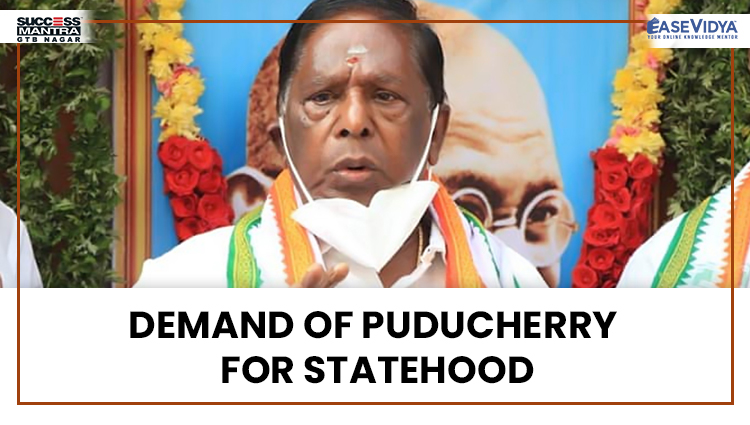
DEMAND OF PUDUCHERRY FOR STATEHOOD
DEMAND OF PUDUCHERRY FOR STATEHOOD
Chief Minister N. Rangasamy expressed confidence that the Center would grant Statehood for the Union Territory of Puducherry. Addressing the inauguration of the Puducherry Print and Television Journalists' Association, Mr. Rangasamy, who heads the AINRC-BJP coalition government in Puducherry, said Statehood status had been a long-standing demand of the Union Territory.
The Chief Minister said the government was implementing several schemes for the betterment of journalists and promised to consider the proposals submitted by the office-bearers of the Association.
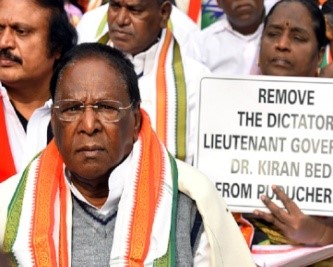
Promise of full statehood for Puducherry
All India N.R. Congress (AINRC) ahead of the polls in Puducherry in 2021 had promised a full statehood for the Union Territory in its election manifesto. The AINRC along with BJP has won the elections, in which, AINRC bagged 10 seats out of the 16 it contested in the legislative polls, while the Bharatiya Janata Party had won 6 seats out of 9 seats it contested. The demand for Statehood is a long pending issue for Puducherry making it unable to exercise any powers for creating employment potential by inviting more industries to Puducherry and also creating infrastructure facilities for tourism.
Current Affairs Notes By Success Mantra Coaching Institute GTB Nagar Delhi CLICK HERE
WHAT IS A UNION TERRITORY?
UT refers to those federal territories that are too small to be independent or are too different (economically, culturally and geographically) to be merged with the surrounding states or are financially weak or are politically unstable. Due to these reasons, they couldn't survive as separate administrative units and needed to be administered by the Union Government.
UTs are administered by the President. In the UTs Lieutenant Governors are appointed by the President of India as their administrators. However, Puducherry, Jammu and Kashmir and Delhi are the exception in this regard and have an elected legislature and government due to the status of partial statehood.
At present, India has 8 UTs-- Delhi, Andaman and Nicobar, Chandigarh, Dadra and Nagar Haveli and Daman and Diu, Jammu and Kashmir, Ladakh, Lakshadweep, and Puducherry.
BACKGROUND OF THE ISSUE
When the Constitution of India was adopted in 1949, the Indian federal structure included:
- Part A: Former British India provinces that had a Governor and a legislature.
- Part B: The former Princely States that were governed by a Rajpramukh.
- Part C: Chief Commissioners' provinces and some princely states that were governed by Chief Commissioner.
- Part D: Territory of Andaman and Nicobar Islands that was governed by a Lieutenant Governor who was appointed by the Central Government.
After the States Reorganisation Act of 1956, Part C and Part D states were combined into a single category of 'Union Territory'. The concept of the UT was added by the Constitution (Seventh Amendment) Act, 1956.
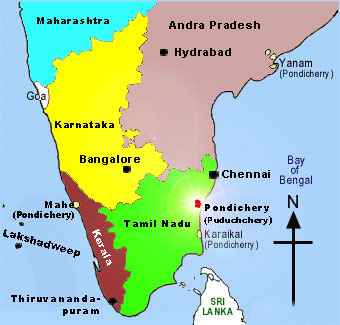
Reasons for Demand:
Linguistic and cultural reasons are the primary basis for creating new states in the country.
Other factors are:
- Competition for local resources.
- Government negligence towards certain regions
- Improper allocation of the resources,
- Difference in culture, language, religion, etc.
- The economy's failure to create enough employment opportunities
- Popular mobilization and the democratic political process is also one of the reasons.
- ‘The sons of the soil'
ISSUES ARISING DUE TO CREATION OF NEW STATES
Different statehood may lead to the hegemony of the dominant community/ caste/ tribe over their power structures. This can lead to emergence of intra-regional rivalries among the sub-regions. The creation of new states may also lead to certain negative political consequences like a small group of legislators could make or break a government at will. There is also a possibility of increase in the inter-State water, power and boundary disputes. The division of states would require huge funds for building new capitals and maintaining a large number of administrators as was the case in the division of Andhra Pradesh and Telangana. Creation of smaller states only transfers power from the old state capitol to new state capital without empowering already existing institutions like Gram Panchayat, District Collector, etc. rather diffusion of development in the backward areas of the states.
Constitutional Provisions: The Indian constitution empowers the Union government to create new states out of existing states or to merge one state with another. This process is called reorganization of the states. As per Article 2 of the Indian Constitution, Parliament may by law admit into the Union, or establish, new States on such terms and conditions. As per Article 3 of the Indian Constitution, the Union Government has the power to form a State, increase or decrease the size of any State, and alter the boundaries or name of any State.
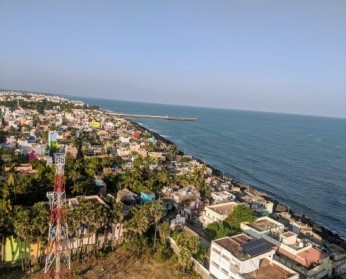
Puducherry
- Puducherry city is capital of Puducherry UT in southeastern India. UT was formed in 1962 out of the four former colonies of French India:
- Pondicherry (now Puducherry) and Karaikal along India’s southeastern Coromandel Coast, Yanam, farther north along the eastern coast, and Mahe, lying on the western Malabar Coast, surrounded by Kerala state. It originated as a French trade center in 1674, when it was purchased from a local ruler. The colony of Pondicherry was the scene of frequent fighting between the French and Dutch in the late 17th century, and it was occupied several times by British troops. However, it remained a French colonial possession until it was transferred to India in 1962
Other announcements for Puducherry
The Chief Minister announced in the legislative assembly that the monthly assistance given to the freedom fighters under the state government scheme as pension will be raised to Rs. 10,000 from the present Rs. 9,000. The Puducherry government has decided to exempt the students selected through the Centralized Admission Committee for engineering and medical students from paying tuition fees. The Chief Minister informed that the monthly assistance given to the aged press persons will be hiked to Rs. 8,000 from present Rs. 7,500. The internship allowance by the government to the medical residents will be raised from the present Rs. 5,000 to Rs. 20,000. All the vacancies in different posts of jobs in the Puducherry government will also be filled and police personnel will be recruited soon. The Chief Minister also said that the loans borrowed from the Backward Welfare Corporation by the students belonging to Backward Class for their education will also be waived.
Sanction of central grants to Puducherry budget:
Chief Minister N Rangasamy informed that he has requested PM Modi to sanction the central grants to the Puducherry budget under 90:10 ratio, with the Central Government’s contribution at 90% of the total requirements and the territorial government’s share being 10%. Currently, the ratio is 60:40.
PRAVAHINI Current Affairs Notes By Success Mantra Coaching Institute GTB Nagar Delhi CLICK HERE
TEST YOURSELF
Q.1 Currently, India has 8 Union Terrorist. Consider the given options & state which of the following is not one of them?
- Jammu & Kashmir
- Puducherry
- Leh: ANSWER
- Lakshadweep
Q.2 After the ___________ Part C and Part D states were combined into a single category of 'Union Territory'?
- Jammu & Kashmir Reorganization 2019
- State of Reorganization Act, 1956
- Administration of Union Territories Act, 1987: ANSWER
- None of the above
Q.3 Consider the given statements & state which of the following is/are incorrect in the reference to the above mentioned passage?
- UT refers to those federal territories that are too small to be independent or are too different (economically, culturally and geographically) to be merged with the surrounding states or are financially weak or are politically unstable.
- UTs are administered by the Prime Minister of India. In the UTs Lieutenant Governors are appointed by the President of India as their administrators.
- Only I is incorrect
- Only II is correct: ANSWER
- Both I & II is incorrect
- None of the following
Q.4 As per which of the following articles of the Indian Constitution, Parliament may by law admit into the Union, or establish, new States on such terms and conditions?
- Article 3: ANSWER
- Article 11
- Article 32
- None of the above-mentioned
Q.5 Consider the following statements and state which of the following is correct in the context of Administration of the Union Territories?
- Article 243 to 255 under Part VIII of the Indian Constitution deals with the administration of Union Territories.
- An administrator or the Lieutenant Governor of the union territory holds the same power as Governor of a State.
- The Union Territories of Puducherry, Delhi and Jammu and Kashmir are provided with a legislative assembly and a council of ministers headed by a chief minister: ANSWER
- None of the above











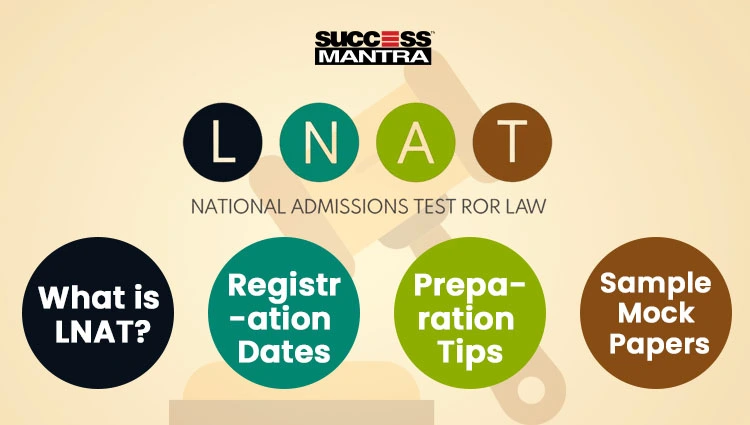

0 Comment